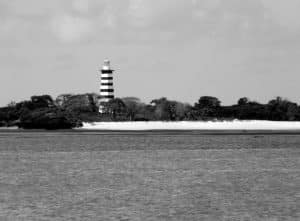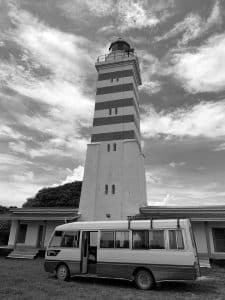Introduction to Ras Mkumbi Lighthouse
Nestled along the stunning coastline of Tanzania, the Ras Mkumbi Lighthouse stands as a testament to the country’s rich maritime history. This iconic structure, with its striking red-and-white exterior, has been guiding seafarers through the treacherous waters of the Indian Ocean for over a century. As you approach the lighthouse, you can’t help but feel a sense of awe and wonder, knowing that it has been a beacon of safety and navigation for generations of sailors.
Historical Significance of Ras Mkumbi Lighthouse

The Ras Mkumbi Lighthouse has a fascinating history that is deeply intertwined with Tanzania’s colonial past. Built in the late 19th century by the German colonial administration, the lighthouse was a strategic asset in their efforts to control the region’s maritime trade routes. Over the years, it has witnessed the ebb and flow of colonial powers, serving as a silent witness to the struggles and triumphs of the Tanzanian people.
Location and Architecture of the Lighthouse
Situated on the northern tip of the Ras Mkumbi peninsula, the lighthouse commands a breathtaking view of the Indian Ocean. Its distinctive red-and-white tower, standing tall at 30 meters, can be seen from miles away, guiding ships through the treacherous waters. The lighthouse’s architecture is a blend of colonial-era design and local influences, with intricate carvings and decorative elements that reflect the region’s rich cultural heritage.
Importance of Lighthouses in Maritime Navigation
Lighthouses like Ras Mkumbi have played a crucial role in maritime navigation for centuries. These towering beacons serve as vital navigational aids, helping ships safely navigate through hazardous waters and avoid treacherous reefs and shoals. The light emitted from the lighthouse’s powerful lamp can be seen for miles, providing a vital lifeline for seafarers in times of distress or poor visibility.
Exploring the Surrounding Area of Ras Mkumbi Lighthouse
The area surrounding the Ras Mkumbi Lighthouse is a true natural wonder. The peninsula is home to a diverse array of flora and fauna, including migratory birds, marine life, and stunning coastal landscapes. Visitors can explore the rugged cliffs, picturesque beaches, and lush mangrove forests that surround the lighthouse, immersing themselves in the region’s breathtaking natural beauty.
Activities and Attractions Near Ras Mkumbi Lighthouse
In addition to the lighthouse itself, the Ras Mkumbi area offers a wealth of activities and attractions for visitors to enjoy. Outdoor enthusiasts can engage in activities like hiking, birdwatching, and beachcombing, while those seeking a more cultural experience can visit nearby villages and learn about the region’s rich heritage. The nearby Saadani National Park is also a popular destination, offering the opportunity to witness the incredible wildlife of Tanzania’s coastal regions.
How to Visit Ras Mkumbi Lighthouse
Visiting the Ras Mkumbi Lighthouse is a relatively straightforward process, but it’s important to plan your trip carefully. The lighthouse is located in a remote area, so you’ll need to arrange for transportation, either by car or boat, to reach the site. Once you arrive, you’ll have the opportunity to explore the lighthouse’s interior, climb to the top of the tower, and immerse yourself in the rich history and natural beauty of the surrounding area.
Interesting Facts and Trivia About Ras Mkumbi Lighthouse
The Ras Mkumbi Lighthouse is a treasure trove of fascinating facts and trivia. For example, did you know that the lighthouse’s distinctive red-and-white color scheme was intentionally designed to make it more visible to passing ships? Or that the lighthouse’s original lamp, powered by kerosene, was later replaced with a more modern electric system? These and other intriguing details about the lighthouse’s history and operation are sure to captivate visitors.
Preservation Efforts and Future Plans for the Lighthouse

In recent years, the Tanzanian government and various conservation organizations have made concerted efforts to preserve and maintain the Ras Mkumbi Lighthouse. These efforts have included restoration work on the tower’s structure, upgrades to the lighting and navigation systems, and the development of educational programs and visitor facilities to enhance the visitor experience. As the lighthouse continues to stand as a beacon of Tanzania’s maritime heritage, there are exciting plans in the works to further enhance its role as a cultural and educational landmark.
Conclusion: The Enduring Legacy of Ras Mkumbi Lighthouse in Tanzania’s Marine Heritage
The Ras Mkumbi Lighthouse is more than just a physical structure; it is a testament to Tanzania’s rich maritime history and a symbol of the country’s resilience and determination. As you stand in the shadow of this iconic lighthouse, you can’t help but feel a deep sense of connection to the generations of seafarers and coastal communities who have relied on its guiding light for over a century. Whether you’re a history buff, a nature enthusiast, or simply someone who appreciates the beauty and significance of such a remarkable landmark, a visit to the Ras Mkumbi Lighthouse is sure to leave a lasting impression on your heart and mind.
For more articles related to Marine Transport in Tanzania click here!
































